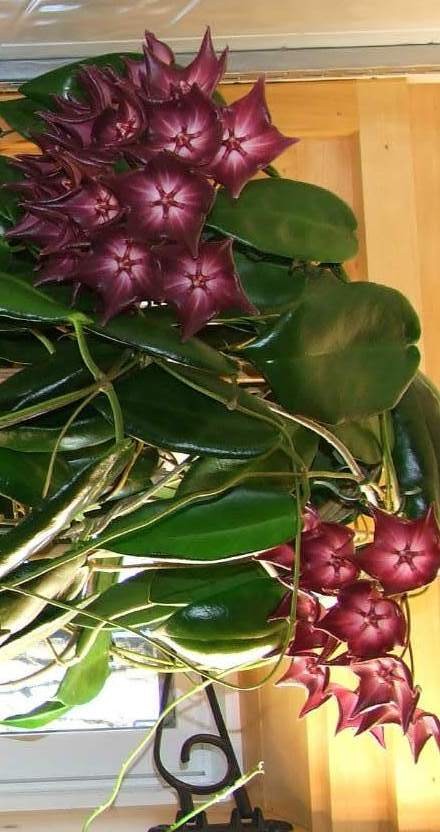Giant wax plant
(Hoya macgillivrayi)

Description
Hoya macgillivrayi is a fast-growing vine native to northeastern Australia that was first discovered in Queensland in the McIlwraith and Tozer Range by Frederick Manson Bailey. The plant was named after William David Kerr Macgillivray, who collected the type specimen. It has oval pointed leaves and has a twining growth habit. The flowers of the plant are approximately 6 cm in diameter and vary slightly in size, shape, and color from each cultivar. They come in umbels of 6 to 10 flowers that are each connected at a central axis. Each flower is a dark burgundy color with five sepals and five petals. The stamen are enclosed in the corona. The fruit produced are two pairs of follicles that are 25 cm long from which a flat seed is produced that is distributed by the wind. The seed takes a long time to germinate. The plant requires well-drained soil and prefers to stay dry during the winter time. It also likes to be kept rootbound. It requires protection in temperate climates, where it may be used as a houseplant. It is listed as Rare on the 1997 IUCN Red list. Hoyas are evergreen perennial creepers or vines or rarely, shrubs. They often grow epiphytically on trees; some grow terrestrially, or occasionally in rocky areas. They climb by twining, and with the employment of adventitious roots. Larger species grow 1–18 m (3–59 ft), or more, with suitable support in trees. They have simple entire leaves, arranged in an opposite pattern, that are typically succulent. Leaves may exhibit a variety of forms, and may be smooth, felted or hairy; venation may be prominent or not, and many species have leaf surfaces flecked with irregular small silvery spots. The flowers appear in axillary umbellate clusters at the tip of peduncles. Hoya peduncles are commonly referred to as spurs. In most species these spurs are perennial and are rarely shed. Each flowering cycle increases the length of the spur, and in the larger species can eventually reach 27 cm (11 in) or more. Flowers vary in size from 3 mm (1⁄8 in) (Hoya bilobata Schltr.) to over 95 mm (3+3⁄4 in) (in H. lauterbachii K. Schuman) in diameter. Flower form is typically star-shaped, with five thick, waxy, triangular petals, topped with another star-shaped structure, the corona. Colours on most species range from white to pink; there are species that exhibit yellow to orange, dark reds to near-black, and there are green flowers. Many are sweetly scented. and most produce abundant nectar.
Taxonomic tree:







